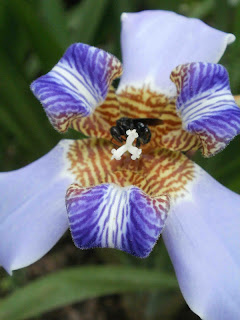Publisher's declaration: I made it to Panama and unable to continue overland to Colombia because of a lack of an overland route. I returned to the USA to assess onward travel, and recuperate from on injury sustained while jumping onto a moving bus while holding my 35 pound backpack in my right arm. Don’t try it at home. I was unable to use my right arm for a couple of months. Below is a brief update from Part 1 of the journey.
Nicaragua
After Mirafor, I explored Managua (hectic, traffic, construction everywhere), Granada (colonial atmosphere, expensive for Nicaragua, full of foreign travelers), Masaya (few tourist, excellent local craft market, hotbed of anti-Sandinista organizing), and Isla Ometepe (rural, undeveloped, butterflies everywhere).
Isla Ometepe in the middle of Lake Nicaragua
Typical housing on the Isla
Horses and laundry by hand are still in practice
Nicaragua was the most interesting country I visited during this part of the journey. It can either explode into the next eco friendly destination, or regress into revolution and destruction. The people have not been exposed to many foreigners, therefore they’re genuinely interested in getting to know you and finding out about your life.
Costa Rica
I stopped in Liberia (ate a scrumptious prawn stew), Puntarenas (rhythmic music, dancing in the streets, outstanding seafood), Quepos (expensive, grown into a beach destination, ate my best meal on the trip), San Isidro (superb hiking, overwhelming abundance of flora and fauna, a naturalist’s paradise).
Prawn stew at its best
Dancing in the streets of Puntarenas
Sleepy Quepos has been discovered and developed
Quepos farmer's market (is that a gringo?)
Delicious salmon carpaccio in Quepos
The country has been discovered by foreign travelers. The locals see so many tourists that they’re indifferent to you as a person. They mostly see you as an economic tool to be sold goods or services. There are still hidden areas to be explored. I found one, but it will remain a secret (send me an e-mail and I’ll tell you about it).
Flowers of Costa Rica
Cacao fruit which contain cocoa beans that are used
to make chocolate
A honey bee working in the cloud forest of Costa Rica
Panama
I discovered an area I would move to - Boquete (flowers and coffee abound, in the mountains surrounded by volcanos, large American and European expatriate community). I lost my way hiking the Quetzal trail. I used my compass to relocate the trail. The most invigorated I felt on the journey.
Boquete in the foothills of a cloud rain forest
Hiking into the jungles of Panama
No roads, no development, no people . . . only wilderness
Manny de lost in the jungles of Panama (he looks a little worried)
The Quetzal trail: I was elated when I rediscovered it
When visiting Panama City, I thought I was in the USA (currency is American dollars, many diverse people). There is actually three cities. The first, Panama Viejo, is in ruins sacked and burnt by pirate Henry Morgan. The second, Casco Viejo, is refurbishing its aging colonial architecture and relocating it’s current poor inhabitants to make way for the next big tourist destination. Modern Panama is empty skyscrapers (construction boom gone bust) scurrying people, and striking city scape.
Modern bus with air conditioning, movies, and bus attendants.
How did they get that bus in that space?
Casco Viejo: soon to be refurbished
Modern Panama City
I toured the Panama Canal that left me in awe of the engineering feats we’re capable of. I rode the Panama Canal train (on land) to Colon on the Atlantic coast. It’s only 50 miles from the Pacific to the Atlantic coast. Colon is dangerous, run down, and best to leave right away.
Miraflores locks at the Panama Canal
Conductors on the Panama Canal train
There are no roads from Panama to Colombia. The impenetrable Darien jungle separates these countries. The local indigenous people dislike and are suspicious of outsiders. There are gigantic deadly snakes, insects, and exotic disease unknown to modern humans. The only way to Colombia is by airplane or boat. I booked my air passage to Bogota, Colombia. First, I'll go home to California to regroup.
November 2011: Welcome home reception
I've started my exploration of South America. I landed in Bogota, Colombia yesterday (September 5, 2012). I'm following the footsteps of Gonzalo Jimenez Quesada (conquerer of Colombia). Part 2 of this journey will take us to Colombia, Ecuador, Peru, and Bolivia. I'll see you in the Andes . . . .






















manny! love the reading and the pics!
ReplyDelete